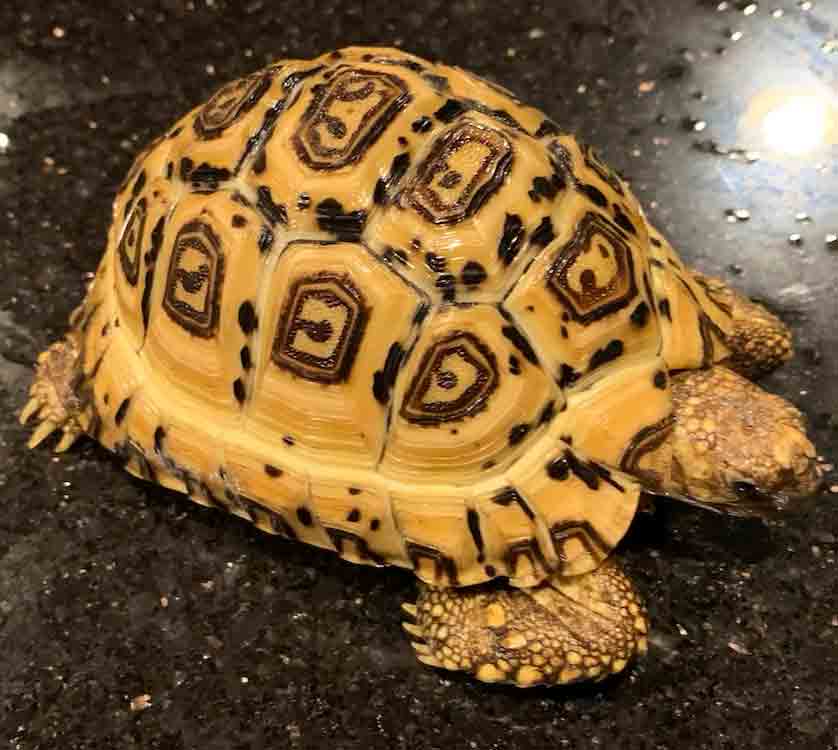Stigmochelys pardalis (Leopard Tortoise)
Home > Turtle Database > Stigmochelys pardalis (Leopard Tortoise)

Stigmochelys pardalis, known as the leopard tortoise, is a large, slow-moving tortoise species found in the grasslands and savannas of eastern and southern Africa. Its name comes from the bold, black and yellow pattern on its shell, which resembles the spots of a leopard.
Native To These Regions
Angola, Botswana, Democratic Republic of the Congo, Eastern Cape (South Africa), Ethiopia, Free State (South Africa), Gauteng (South Africa), Kenya, KwaZulu-Natal (South Africa), Limpopo (South Africa), Mpumalanga (South Africa), Namibia, North West (South Africa), Northern Cape (South Africa), Somalia, South Sudan, Sudan, Tanzania, Uganda, Western Cape (South Africa), Zambia, ZimbabweNative Turtle Species Map – Find Turtles by Region
Scientific Classification
Kingdom: Animalia
Phylum: Chordata
Class: Reptilia
Order: Testudines
Family: Testudinidae
Genus: Stigmochelys
Species: Stigmochelys pardalis
Common Names
Leopard tortoise
This Hilarious Turtle Book Might Know Your Pet Better Than You Do
Let’s be real—most turtle care guides feel like reading a textbook written by a sleep-deprived zookeeper.
This one’s not that.
Told from the snarky point of view of a grumpy, judgmental turtle, 21 Turtle Truths You’ll Never Read in a Care Guide is packed with sarcasm, sass, and surprisingly useful insights.
And hey—you don’t have to commit to the whole thing just yet.
Grab 2 free truths from the ebook and get a taste of what your turtle really thinks about your setup, your food choices, and that weird plastic palm tree.
It’s funny, it’s honest, and if you’ve ever owned a turtle who glares at you like you’re the problem—you’ll feel seen.
Identification
Description
The leopard tortoise has a high-domed shell covered in yellow and black markings, which vary from bold spots to irregular blotches. Its legs are thick and sturdy, adapted for walking long distances across dry grasslands. Adults range from 12 to 18 inches in length, but some individuals can grow larger in certain regions.
Sexual Dimorphism
Males are usually smaller than females, but they have longer tails. Males also have a more concave plastron, which helps them mount females during mating.
Native Origin and Distribution
Geographical Range
Leopard tortoises are found across much of sub-Saharan Africa, from Sudan and Ethiopia down to South Africa. They are common in countries like Kenya, Tanzania, Botswana, and Namibia.
Preferred Habitat
Leopard tortoises prefer open grasslands, savannas, and semi-arid scrublands. They avoid dense forests and deserts but thrive in areas with a mix of grasses and shrubs, which provide both food and shelter.
Behavior
Feeding Habits
Leopard tortoises are herbivores, feeding mainly on grasses, succulents, and other low-growing plants. They also eat mushrooms, fruits, and even old bones or hyena scat to obtain calcium.
Predators
Young leopard tortoises face threats from jackals, monitor lizards, birds of prey, and mongooses. Adults have fewer natural predators, but lions, hyenas, and humans can still pose a threat.
Reproduction
Breeding Season
Mating can happen year-round, but it often peaks during or after the rainy season when food is more abundant.
Reproductive Method
Females dig nests in sandy soil and lay clutches of 5 to 30 eggs. Incubation lasts 8 to 15 months, depending on temperature. Hatchlings emerge small and vulnerable, with soft shells.
Conservation
Extinction Status
Leopard tortoises are listed as Least Concern, but some populations face local declines.
Threats
Habitat loss from farming, road construction, and human settlement affects their numbers. Collection for the pet trade and illegal hunting also pose risks, especially in certain regions.
Conservation Measures
Protected reserves and education programs about sustainable tortoise collection help protect this species. In some areas, conservation groups relocate tortoises from dangerous areas to safer habitats.
Economic Importance
Leopard tortoises are sometimes sold in the international pet trade, especially in countries where exotic pets are popular. They also play a role in traditional African medicine and cultural practices in some regions. In their natural habitat, they help shape the ecosystem by grazing and spreading seeds through their droppings.
Interesting Facts
Leopard tortoises are strong swimmers, even though they live in dry areas. They can cross rivers and streams when needed.
Unlike many other tortoises, they don’t dig burrows but will shelter in abandoned aardvark holes during extreme heat or cold.

About Author
Muntaseer Rahman started keeping pet turtles back in 2013. He also owns the largest Turtle & Tortoise Facebook community in Bangladesh. These days he is mostly active on Facebook.











